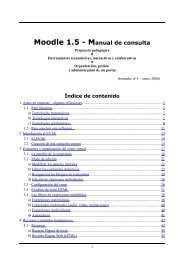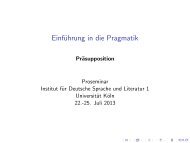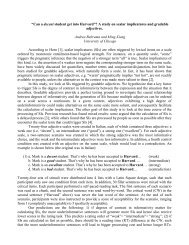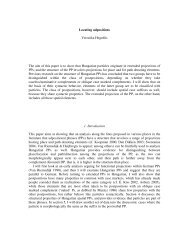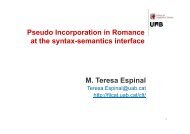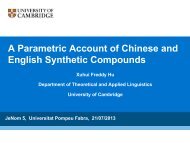Semantic aspects of differential object marking - corpora@parles.upf ...
Semantic aspects of differential object marking - corpora@parles.upf ...
Semantic aspects of differential object marking - corpora@parles.upf ...
You also want an ePaper? Increase the reach of your titles
YUMPU automatically turns print PDFs into web optimized ePapers that Google loves.
<strong>Semantic</strong> <strong>aspects</strong> <strong>of</strong> <strong>differential</strong> <strong>object</strong> <strong>marking</strong> 3<br />
(2) ñaan teeñña vaññi.<br />
I coconut<br />
‘I bought a coconut.’<br />
buy.PAST<br />
In (1) the animate <strong>object</strong> ‘cow’ appears in the accusative case whereas the inanimate <strong>object</strong><br />
‘coconut’ in (2) appears without overt case <strong>marking</strong>. A similar DOM pattern based on animacy<br />
is found in Guaraní (Bossong 1985b). A DOM system based on the definiteness <strong>of</strong> the <strong>object</strong> is<br />
found in the Semitic language Hebrew:<br />
HEBREW (Semitic; Aissen 2003:453)<br />
(3) Ha-seret herPa ’et-ha-milxama.<br />
the-movie showed ET-the-war<br />
‘The movie showed the war.’<br />
(4) Ha-seret herPa (*’et)-milxama.<br />
the-movie showed ET-war<br />
‘The movie showed a war.’<br />
When the direct <strong>object</strong> ‘war’ is definite as in (3) it is preceded by the <strong>object</strong> marker ’et. In<br />
case the <strong>object</strong> is indefinite as in (4) use <strong>of</strong> the <strong>object</strong> marker is excluded. 1 Definiteness and/or<br />
specificity influence DOM in many other languages such as Persian (Karimi 1996), Turkish<br />
(von Heusinger and Kornfilt 2005), and Amharic (Amberber 2005). The recurrent pattern in<br />
these languages is that only definite/specific <strong>object</strong>s are overtly case marked. The languages<br />
discussed so far are so-called one-dimensional DOM languages. That is, DOM in these languages<br />
is related to a single semantic feature be it either animacy or definiteness/specificity.<br />
There are also languages in which a combination <strong>of</strong> these features influences <strong>object</strong> case <strong>marking</strong>.<br />
Such systems can be referred to as two-dimensional DOM systems (cf. Aissen 2003) and<br />
are, for instance, attested in Hindi (e.g., Mohanan 1990) and many Romance languages (e.g.,<br />
Spanish, Rumanian, Sardinian; see Bossong 1991 for references).<br />
Thus, in Spanish direct <strong>object</strong>s can be preceded by the prepositional <strong>object</strong> marker a depending<br />
on the animacy and definiteness/specificity <strong>of</strong> the <strong>object</strong>. 2 The contrast between animate and<br />
inanimate <strong>object</strong>s is illustrated with the following three examples:<br />
SPANISH (Romance; Bleam 2005:3-4)<br />
(5) Mari vió a la mujer.<br />
Mari saw A the woman<br />
‘Mari saw the woman.’<br />
(6) Mari vió al gato.<br />
Mari saw A.the cat<br />
‘Mari saw the cat.’<br />
(7) Mari vió (*a) la mesa.<br />
Mari saw A the table<br />
‘Mari saw the table.’<br />
1Danon (2001) argues that the exact parameter is the occurrence <strong>of</strong> a definite article rather than semantic<br />
definiteness.<br />
2Von Heusinger and Kaiser (2003) argue that in Standard Spanish animacy and specificity are the factors involved<br />
whereas in (South-)American variants <strong>of</strong> Spanish definiteness and specificity but not animacy influence<br />
DOM.<br />
600<br />
3




